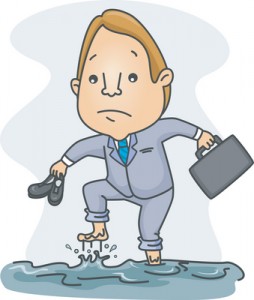
Fires in or around server rooms and data centers can ruin your data and put your business at risk. It’s a must to set up fire protocols when you build your room or building.
As I mentioned in Part One of “When Nature Strikes,” the two most important protocols to have in place for any “in case of…” are 1) Have a Plan and 2) Secure Your Data. When dealing with the possibility of fire destroying your server room or data center, you’ll want to make sure you also have Suppression, Containment and Insurance protocols in place as well.
Have a Plan
Disaster recovery plans are now becoming a requirement for many industries. To be prepared, businesses need to locate and define the regulatory requirements of their individual industry, which will also help avoid fines, penalties or negative press associated with noncompliance.
Trying to implement or even design a plan while in the middle of a disaster will only lead to a less than successful recovery. Make sure your team is ready for action and everyone knows what to do. It’s better to be overprepared than have a plan that goes up in flames.
Secure Your Data
Back up your data regularly. Manage a duplicate copy of all data, programming, and company processes at a different physical location or in the cloud. That way, you can continue working at a secondary location if your system crashes. One way to do that is to keep copies of all your data, programs, bare metal backups and virtual machines in data centers in other states.
If you maintain data backups and business software on location, make sure you store them in a fire rated safe. Fire safes can be purchased anywhere from $100 to thousands of dollars for a fully-loaded safe.
Suppression
Fire suppression systems for server rooms and data centers are essential to the server room itself. A fire suppression system will automatically extinguish a fire without the need of human intervention.
Design standards for fire suppression systems for server rooms and data centers are carried out with strict guidelines as the fire suppression agents used can be dangerous if not designed correctly. Fires within these types of environments are suppressed in two different ways.
Reduce Oxygen – This method uses argon, nitrogen and sometimes carbon monoxide to displace the oxygen in the room. The objective of this method is to reduce the oxygen level to below 15% in the room. By reducing oxygen to this level, it will suppress the fire.
Chemical and Synthetic – Most chemical and synthetic fire suppression agents have some form of a cooling mechanism. These systems use less gas and maintain a higher level of oxygen. However, high doses of any synthetic or chemical agent can be toxic, so making sure your design is correct is absolutely necessary. Synthetic fire suppression systems will deliver its payload within ten seconds.
Containment
A fire doesn’t have to be inside your data center to jeopardize IT equipment. Because radiant heat and smoke from fire in an adjacent room can be enough to damage sensitive network hardware, creating a protective barrier between your server room and the potential fire not only blocks indirect damage, but prevents flame spread as well.
Lightweight, flame-resistant ceramic panels can be used to build fire-safe archive rooms and data centers within larger, standard-construction buildings.
Insurance
Recovering from fire damage is expensive. Business insurance is crucial and it’s not only for physical property. The right kind of insurance will replace lost income as well. Make sure your business insurance policy is up to date and has the correct coverage to support your business in crisis mode.
Make sure you have all of your suppression and containment systems built and installed by certified professionals. Insurance companies will require this in order for you to acquire the policy and even collect on it.
No one wants to get burned after a fire. Again, make sure your company insurance is up to date and has the appropriate coverage needed to rebuild your business.
If you have questions or you’re looking for suggestions on prepping your business for recovery, not disaster, call Tech Experts at (734) 457-5000.
(Image Source: iCLIPART)

 backup of your files, documents, folders and data bases. If you require bare metal backups or the ability to convert your server into a virtual machine to keep afloat until replacement hardware is in place and running, Tech Experts also offers devices that can fulfill that requirement as well.
backup of your files, documents, folders and data bases. If you require bare metal backups or the ability to convert your server into a virtual machine to keep afloat until replacement hardware is in place and running, Tech Experts also offers devices that can fulfill that requirement as well. Spring is a good time to get some cleaning done in your home as well as your office. Here are few tasks and tips you should check off your list, if you own a small business or if you simply are a computer user:
Spring is a good time to get some cleaning done in your home as well as your office. Here are few tasks and tips you should check off your list, if you own a small business or if you simply are a computer user:
 may forget to back up data on machines outside of the company premises.
may forget to back up data on machines outside of the company premises.

